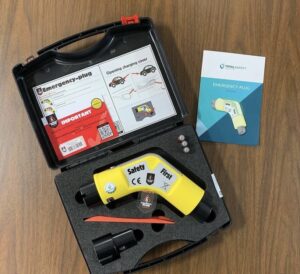Who is a member?
Our members are the local governments of Massachusetts and their elected and appointed leadership.

The Newton Fire Department recently bought five Emergency Plug devices to immobilize electric vehicles involved in accidents. (Photo courtesy Newton Fire Department)
With electric vehicles becoming more popular, the Newton Fire Department has become the second in the nation to secure devices that can immobilize electric vehicles involved in accidents.
Following New York City, Newton has unveiled devices that put electric vehicles “to sleep,” so they can’t move suddenly after an accident and injure emergency responders, passengers or bystanders. Newton has bought five of the devices, as fire departments increasingly confront safety challenges involving electric vehicles.
“Electric vehicles are such a new topic, and everyone is comparing notes and trying to figure out what’s the best practice,” said Newton Fire Capt. Phillip McCully, who leads the department’s safety training efforts. “It’s exciting that Newton gets to be in the forefront of this, and we try to share the lessons we’ve learned, and take the lessons that other people have learned, to try to craft a really concrete and safe electric-vehicle response.”
Electric engines pose specific challenges because they operate more quietly than gas- and diesel-powered engines, and people can have trouble figuring out if an electric vehicle is still running — a problem potentially made more complicated by accident-damaged equipment.
McCully began his research after a viral video in July showed an SUV suddenly moving and rolling over onto a New York City firefighter after it had crashed.
McCully discovered that a couple firefighters in Amsterdam had invented a hand-held device called Emergency Plug that prevents electric vehicles from moving after an accident. He befriended one of the firefighters, and got the devices shipped to Newton. The devices, which cost about $850 to $875 each, arrived just after the holidays and have been placed on different vehicles to ensure coverage throughout Newton.
The yellow device, which also works on hybrid plug-ins, has three adapters to accommodate various car brands. The device plugs into the same port as the charger and instructs the car to shift into neutral or park, depending on the make or model, McCully said. The devices restrict only vehicle movement, not hazards posed by electric-vehicle fires, he said.
According to McCully, the devices are popular with responders in Europe, Asia and the Middle East, but have been slower to catch on here. In general, U.S. responders have only begun grappling with the challenges involving electric vehicles. To help bridge this gap, the National Fire Protection Association has been offering online resources and training for first responders.
“While firefighters have had more than 100 years to learn how to handle incidents with internal combustion engine (ICE) vehicles, they’ve had very little time to understand and train for those involving EV and hybrid vehicles,” said Andrew Klock, the NFPA’s emerging issues lead manager, in a statement last year about training.
More than 180 Newton Fire employees have now been trained on the devices, and McCully said his department recently started analyzing Newton’s accident data to track the percentage of accidents involving electric vehicles.
Since Newton firefighters started posting online about their devices, firefighters from as far away as Hawaii, and as nearby as Concord, have asked about them, McCully said. The department invited firefighters from local departments to attend its trainings, he said, and Newton would willingly deploy the devices to accidents in neighboring communities.